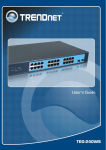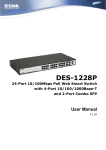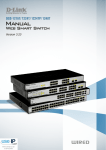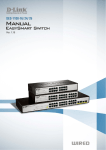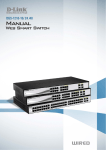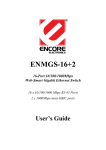Download D-Link 48-Port 10/100Mbps Web-Smart Switch with 4-Port 10/100/1000Base-T and 2-Port Combo SFP DES-1252 User manual
Transcript
DES-1252 48-Port 10/100Mbps Web-Smart Switch with 4-Port 10/100/1000Base-T and 2-Port Combo SFP User Manual V1.00 TABLE OF CONTENTS About This Guide................................................................................. 1 Purpose ............................................................................................ 1 Terms/Usage .................................................................................... 1 Introduction.......................................................................................... 2 Gigabit Ethernet Technology ........................................................... 2 Fast Ethernet Technology ................................................................ 3 Switching Technology ..................................................................... 3 Features............................................................................................ 4 Technical Specifications .................................................................. 5 Unpacking and Installation .................................................................. 9 Unpacking........................................................................................ 9 Installation ....................................................................................... 9 Rack Mounting........................................................................... 10 Connecting Network Cable........................................................ 11 AC Power................................................................................... 12 Identifying External Components ...................................................... 13 Front Panel..................................................................................... 13 Rear Panel ...................................................................................... 14 Understanding LED Indicators ...................................................... 15 Power and System LEDs ............................................................... 15 Configuration ..................................................................................... 19 Supported web browsers ................................................................ 19 Installing the SmartConsole Utility................................................ 19 i SmartConsole Utility Features ....................................................... 20 Menu Toolbar............................................................................. 20 Discovery List............................................................................ 22 Monitor List ............................................................................... 23 Device Setting............................................................................ 25 Web-based Utility .......................................................................... 27 Login.......................................................................................... 27 Tool Menu.................................................................................. 29 Setup Menu .................................................................................... 30 System > System Setting ........................................................... 31 System > Trap Setting................................................................ 32 System > Port Setting................................................................. 33 System > SNMP Setting ............................................................ 35 System > Password Access Control........................................... 37 Configuration > 802.1Q VLAN ................................................. 37 Configuration > Trunking .......................................................... 40 Configuration > IGMP Snooping............................................... 41 Configuration > 802.1D Spanning Tree..................................... 44 Configuration > Port Mirroring.................................................. 47 QoS > 802.1p Default Priority ................................................... 48 Security > Safeguard Engine...................................................... 48 Security > Broadcast Storm Control .......................................... 49 Security > 802.1X Setting.......................................................... 49 Security > Mac Address Table > Static MAC............................ 52 Security > Mac Address Table > Dynamic Forwarding Table .. 53 ii Monitoring > Statistics............................................................... 53 iii ABOUT THIS GUIDE Thank you and congratulations on your purchase of the DES-1252 24Port 10/100Mbps Fast Ethernet with 4-Port 10/100/1000Base-T and 2Port Combo SFP Web-Smart Switch. This device integrates 1000Mbps Gigabit Ethernet, 100Mbps Fast Ethernet and 10Mbps Ethernet network capabilities in a highly flexible package. Purpose This guide will show you how to install and use the configuration functions of the DES-1252 Web-Smart Switch step-by-step. Terms/Usage In this guide, the term “Switch” (first letter capitalized) refers to the DES-1252 Smart Switch, and “switch” (first letter lower case) refers to other Ethernet switches. Some technologies refer to terms “switch”, “bridge” and “switching hubs” interchangeably, and both are commonly accepted for Ethernet switches. 1 INTRODUCTION This chapter will describe the features of the DES-1252 and provide some background information about Ethernet/Fast Ethernet/Gigabit Ethernet switching technology. Gigabit Ethernet Technology Gigabit Ethernet is an extension of IEEE 802.3 Ethernet utilizing the same packet structure, format, and support for CSMA/CD protocol, full duplex, and management objects, but with a tenfold increase in theoretical throughput of over 100-Mbps Fast Ethernet and a hundredfold increase over 10-Mbps Ethernet. Since it is compatible with all 10-Mbps and 100-Mbps Ethernet environments, Gigabit Ethernet provides a straightforward upgrade without wasting existing investments in hardware, software, or trained personnel. The increased speed and extra bandwidth offered by Gigabit Ethernet is essential to help solving network bottlenecks that frequently develop as more advanced computer users and newer applications continue to demand greater network resources. Upgrading key components, such as backbone connections and servers to Gigabit Ethernet technology can greatly improve network response times as well as significantly speed up the traffic between subnets. Gigabit Ethernet enables fast optical fiber connections to support video conferencing, complex imaging, and similar data-intensive applications. Likewise, since data transfers occur 10 times faster than Fast Ethernet, servers outfitted with Gigabit Ethernet NIC’s are able to perform 10 times the number of operations in the same amount of time. 2 In addition, the phenomenal bandwidth delivered by Gigabit Ethernet is the most cost-effective method to take advantage of today and tomorrow’s rapidly improving switching and routing internetworking technologies. And with expected advances in the coming years in silicon technology and digital signal processing that will enable Gigabit Ethernet to eventually operate over unshielded twisted-pair (UTP) cabling, outfitting your network with a powerful 1000-Mbpscapable backbone/server connection which will create a flexible foundation for the next generation of network technology products. Fast Ethernet Technology The growing importance of LANs and the increasing complexity of desktop computing applications are fueling the need for high performance networks. A number of high-speed LAN technologies have been proposed to provide greater bandwidth and improve client/server response times. Among them, 100BASE-T (Fast Ethernet) provides a non-disruptive, smooth evolution from the current 10BASE-T technology. 100Mbps Fast Ethernet is a standard specified by the IEEE 802.3 LAN committee. It is an extension of the 10Mbps Ethernet standard with the ability to transmit and receive data at 100Mbps, while maintaining the CSMA/CD Ethernet protocol. Since the 100Mbps Fast Ethernet is compatible with all other 10Mbps Ethernet environments, it provides a straightforward upgrade and utilizes existing investments in hardware, software, and personnel training. Switching Technology Another approach to push beyond the limits of Ethernet technology is the development of switching technology. A switch bridges Ethernet 3 packets at the MAC address level of the Ethernet protocol transmitting among connected Ethernet or Fast Ethernet LAN segments. Switching is a cost-effective way of increasing the total network capacity available to users on a local area network. A switch increases capacity and decreases network loading by dividing a local area network into different segments, which won’t compete with each other for network transmission capacity. The switch acts as a high-speed selective bridge between the individual segments. The switch, without interfering with any other segments, automatically forwards traffic that needs to go from one segment to another. By doing this the total network capacity is multiplied, while still maintaining the same network cabling and adapter cards. Features ♦ Address Table: Supports up to 8K MAC address per device ♦ Supports a packet buffer of up to 128K Bytes ♦ IGMP Snooping support ♦ IEEE802.1D Spanning Tree ♦ Support static Port Trunk ♦ Port Mirroring support ♦ IEEE802.1Q VLAN ♦ IEEE802.1p Priority Queues ♦ IEEE802.1X Port-based Access Control ♦ Supports Broadcast Storm Control 4 ♦ Supports Static MAC setting ♦ D-Link Safeguard Engine support ♦ Supports Simple Network Management Protocol(SNMP) ♦ MIB support for: RFC1213 MIB II, Private MIB ♦ Supports DHCP client ♦ Supports Port setting for Speed, Duplex Mode ♦ Easy configuration via Web Browser ♦ Easy setting via SmartConsole Utility ♦ Firmware backup and upload via Web GUI ♦ System reboot via Web GUI ♦ Provides parallel LED display for port status such as link/act, speed, etc. ♦ Reset configuration (hardware and Web GUI) Technical Specifications Key Components / Performance Switching Capacity 17.6Gbps 10M: 14,880 pps Max. Forwarding Rate 100M: 148,809 pps 1G: 1,488,095 pps Forwarding Mode Store and Forward Packet Buffer memory 128K Bytes 5 SDRAM for CPU 8M Bytes Flash Memory Prom 2M Bytes Port Functions LAN - 48 x 10/100BaseT ports - Compliant with the following standards: 1. IEEE 802.3 compliance 2. IEEE 802.3u compliance 3. Support Full and Half Duplex operations - 2 Combo 1000Base-T/SFP ports -1000Base-T/SFP ports compliant to the following standards: 1. IEEE 802.3 compliance 2. IEEE 802.3u compliance 3. IEEE 802.3ab compliance 4. Support Full-Duplex operations Combo ports in the front panel - SFP Transceivers Supported: 1. 2. 3. 4. 5. DEM-310GT (1000BASE-LX) DEM-311GT (1000BASE-SX) DEM-314GT (1000BASE-LH) DEM-315GT (1000BASE-ZX) DEM-312GT2 (1000BASE-SX), up to 2km 6. DEM-211 (100BASE-FX), up to 2km, Multi-Mode 7. DEM-210 (100BASE-FX), up to 15km, Single-Mode -WDM Transceivers Supported: 6 1. DEM-330T (TX-1550/RX-1310nm), up to 10km, Single-Mode 2. DEM-330R (TX-1310/RX-1550nm), up to 10km, Single-Mode 3. DEM-331T (TX-1550/RX-1310nm), up to 40km, Single-Mode 4. DEM-331R (TX-1310/RX-1550nm), up to 40km, Single-Mode 2 1000Base-T ports 1000Mbps Copper ports in the front panel 1000Base-T ports compliant to following standards: 1. 2. 3. 4. IEEE 802.3 compliance IEEE 802.3u compliance IEEE 802.3ab compliance Support Full-Duplex operations Chassis Dimensions 19-inch, 1U Rack-mount size 440mm x 310mm x 44mm Reset button on the front panel A factory reset button x 1 Physical & Environment AC input Operation Temperature 100~240 VAC, 50/60Hz Internal universal power supply 0~40°C 7 Storage Temperature -10~70°C Humidity Operation: 10%~90% RH Storage: 5%~90% RH Power consumption 26.6(watts) Heat Dissipation 86.95(btu/hr) MTBF 298917 (hours) Emission (EMI) and Safety Certifications EMI-EMC Compliance: FCC class A, CE Class A, VCCI Class A Safety Compliance: cUL, UL 8 UNPACKING AND INSTALLATION This chapter provides unpacking and installation information for the Web-Smart Switch. Unpacking Carefully unpack the contents of the Web-Smart Switch from the box and locate the following items: One DES-1252 Web-Smart Switch One AC power cord, suitable for the local electrical power voltage requirements Four rubber feet to be used for shock cushioning Screws and two mounting brackets CD-Rom with the SmartConsole Utility application, which includes the full User’s Guide Quick Installation Guide If any item is found missing or damaged, please contact the reseller for replacement. Installation The site chosen for installation greatly affects the Web-Smart Switch’s performance. When installing, consider the following points: Install the Switch in a fairly cool and dry place. See Technical Specifications for the acceptable temperature and humidity operating ranges. 9 Install the Switch in a site free from strong electromagnetic field generators (such as motors), vibration, dust, and direct exposure to sunlight. Leave at least 10cm of space to the front and rear of the Switch for ventilation. Install the Switch on a sturdy, level surface that can support its weight, or in an EIA standard-size equipment rack. For information on rack installation, see the next section, Rack Mounting. When installing the Switch on a level surface, attach the rubber pads (feet) to the bottom. The rubber feet cushion the switch and helps protect the case from scratches. Figure 1 – Attach the adhesive rubber pads to the bottom Rack Mounting The Switch can be mounted in an EIA standard-size, 19-inch rack or chassis, which can be placed in a wiring closet with other equipment. Attach the mounting brackets to both sides of the Switch (one on each side), and secure them with the provided screws. 10 Figure 2 – Attach the mounting brackets to the Switch Use the screws provided with the equipment rack or chassis to mount the Switch in the rack. Figure 3 – Mount the Switch in the rack or chassis Connecting Network Cable The DES-1252 has 48 ports that support 10/100Mbps Fast Ethernet; it also has 4 10/100/1000Base-T Ports and 2 Combo SFPs. Each port on the DES-1252 supports Auto-MDI/MDI-X. AutoMDI/MDI-X is a feature that eliminates the need for worrying about using either a standard or crossover cable—you can use either one—and allows any port to be an uplink port. 11 AC Power The DES-1252 can be used with AC power supply 100~240V AC, 50~60Hz. The power switch is located at the rear of the unit adjacent to the AC power connector and the system fan. The switch’s power supply will adjust to the local power source automatically and may be turned on without having any or all LAN segment cables connected. 12 IDENTIFYING EXTERNAL COMPONENTS This chapter describes the front panel, rear panel, and LED indicators of the Switch. Front Panel The figure below shows the front panel of the Switch. Figure 4 – Front panel of the 28-port Web-Smart Switch Reset button: The Reset button resets all configuration settings back to the factory default. Note: Be sure to save or record any custom settings configured on the Switch before pressing the reset button. Resetting the Switch back to factory default settings will erase all custom configurations. LED Indicator: Comprehensive LED indicators display the status of the switch and the network (see the Understanding LED Indicators section). 10/100 BASE-TX Twisted Pair Ports (Port 1~48) The DES-1252 is equipped with 48 Fast Ethernet twisted pair ports that are auto negotiable 10/100Mbps and also support auto 13 MDI/MDIX crossover detection. All these 48 ports can operate in half- and full- duplex modes. 10/100/1000 BASE-T / Mini GBIC Combo Ports (Option Port 49~50) The Switch is also equipped with two combo 10/100/1000 Base-T / Mini GBIC ports, which supports optional 100 or 1000BASE-SX/LX and 100Base-FX Mini GBIC module for fiber uplinks. 10/100/1000 BASE-T Twisted Pair Ports (Port 51~52) Finally there are 2 Gigabit twisted pair ports that are auto negotiable 10/100/1000Mbps with auto MDI/MDIX crossover detection support that can also operate in half- and full- duplex modes. Note: When a port is set to “Forced Mode”, the Auto MDI/MDIX will be disabled. Rear Panel AC Power Connector Figure 5 – Rear panel of the Switch AC Power Connector: Plug in the female connector of the provided power cord into this 14 connector, and the male into a power outlet. Supported input voltages range from 100-240V AC, and 50-60Hz. Understanding LED Indicators The front panel LEDs provides instant status feedback and simplifies monitoring and troubleshooting tasks. Figure 6 – LED indicators of the Switch Power and System LEDs Power LEDs On When the Power LED light is on, the Switch is receiving power. Off When the Power LED light is off, the power cord is not improperly connected. 15 CPU LEDs ( Management Indicator) Blinking When the CPU is working, the CPU LED is blinking. Off The CPU is idle. Ports 1 ~ 48 Status LEDs Link/Act On When the Link/Act LED light is on, the respective port is successfully connected to an Ethernet network. Blinking When the Link/Act LED is blinking, the port is transmitting or receiving data on the Ethernet network. Off No link. Option Ports 49~50 10/100/1000 Base-T / Mini-GBIC Status LEDs Link/Act for Mini GBIC Ports On When the FX Link LED light is on, the respective port is connected to a 100 or 1000Mbps Gigabit Ethernet network. Off No link. 16 Link/Act for UTP ports On When the Link/Act LED light is on, the respective port is connected to a 10/100 or 1000MBps Ethernet network. When the port speed is 1000Mbps, this LED will be shown in Green light. Otherwise, it will be shown in Amber light. Blinking When the LED is blinking, the respective port is transmitting or receiving data on a network. Off No link. Ports 51~52 10/100/1000 Base-T LEDs Link/Act On When the Link/Act LED light is on, the respective port is successfully connected to a 1000Mbps Gigabit Ethernet network. Blinking When the Link/Act LED is blinking, the port is transmitting or receiving data on the Ethernet network. Off No link. 10/100Mbps (shown in Amber Light) On When the Link/Act LED light is on, the respective port is successfully connected to an Ethernet network. 17 Blinking When the Link/Act LED is blinking, the respective port is transmitting or receiving data on the Ethernet network. Off No link. 18 CONFIGURATION Through a web browser, the features and functions of the DES-1252 Switch can be configured for optimum use. Supported web browsers The embedded Web-based Utility currently supports the following web browsers: • • • • • • Microsoft Internet Explorer ver. 6.0, 5.5 Mozilla ver. 1.7.12, 1.6 Firefox ver. 1.5, 1.0.7 Netscape ver. 8.0.4, 7.2 Opera ver. 8.5, 7.6 Safari ver. 2.0.2 Installing the SmartConsole Utility The SmartConsole Utility allows a user to monitor and configure multiple D-Link Web Smart Switches from a workstation connected to the network. Follow these steps to install the SmartConsole Utility: 1. Insert the Utility CD in your CD-Rom Drive. 2. From the Start menu on the Windows desktop, choose Run. 3. In the Run dialog box, type D:\SmartConsole Utility\setup.exe (D:\ represents the driver letter of your CD-ROM) and click OK. 4. Follow the on-screen instructions to install the utility program. 5. Upon completion, go to Program Files > SmartConsole Utility and execute the SmartConsole Utility. 19 SmartConsole Utility Features The SmartConsole Utility is divided into four parts, a Menu Toolbar of functions at the top, Discovery List, Monitor List, and Device Setting. Figure 7 – SmartConsole Utility Menu Toolbar The Menu Toolbar in the SmartConsole Utility has four main tabs, File, View, Option, and Help. File includes: Monitor save, Monitor save as, Monitor load and Exit. • Monitor Save: To record the setting of the Monitor List as default for the next time the SmartConsole Utility is used. • Monitor Save As: To record the setting of the Monitor List in an appointed filename and file path. 20 • Monitor Load: To manually load a Monitor List setting file. • Exit: To exit the SmartConsole Utility. View includes: View log and Clear Log functions, which provide trap setting list operations. • View Log: To show the event of the SmartConsole Utility and the device. • Clear Log: To clear all log entries. Option includes: Refresh Time and Group Interval functions. • Refresh time refreshes the monitoring time of the device. Choices include 15 secs, 30 secs, 1 min, 2 min and 5 min for selecting the monitoring time intervals. • Group Interval establishes the intervals (in seconds) that the Web-Smart Switch will be discovered in the SmartConsole Utility Discovery List. NOTE: If the Group Interval is set to 0, IGMP snooping must be disabled or else the Web-Smart Switch will not be discovered. 21 Help includes: information About the SmartConsole Utility, such as the software version. Discovery List This is the list where all Web-Smart devices on the network are discovered. By pressing the Discovery button, all the Web-Smart devices are listed in the discovery list. Double click or press the Add to monitor list button to select a device from the Discovery List and add it to the Monitor List. Definitions of the Discovery List features: MAC Address: Shows the device MAC Address. IP Address: Shows the current IP addresses of devices. Protocol version: Shows the version of the Utility protocol. Product Name: Shows the device product name. System Name: Shows the appointed device system name. 22 DHCP: uses a client/server model to obtain lease of an IP address from a DHCP server as part of the network boot process. Location: Shows the appointed description for the device location. Trap IP: Shows the IP where the Trap information will be sent. Subnet Mask: Shows the Subnet Mask set of the device. Gateway: Shows the Gateway set of the device. Group Interval: Shows the Group Interval of the device. Monitor List All Web-Smart devices in the Monitor List can be monitored, with Trap information available to be received for monitoring status information of the device. Definitions of the Monitor List functions and terms: S: Shows the system symbol of the Web-Smart device, represents the device system is inactive. IP Address: Shows the current IP address of the device. MAC Address: Shows the device MAC Address. Protocol version: Shows the version of the Utility protocol. Product Name: Shows the device product name. System Name: Shows the appointed device system name. DHCP: uses a client/server model to obtain lease of an IP address from a DHCP server as part of the network boot process. Location: Shows the appointed description for the device location. Trap IP: Shows the IP where the Trap to be sent. Subnet Mask: Shows the Subnet Mask set of the device. Gateway: Shows the Gateway set of the device. 23 Group Interval: Shows the Group Interval of the device. View Trap: The view trap function receives trap events from the Web-Smart Switch. There is a light indicator to the left of the “View Trap” button. A green light indicates that the monitor has not received any new traps, while a red light indicates that there are new traps received by the monitor available to view. (Figure 8) Figure 8 – View trap When the “View Trap” button is clicked, a Trap Information window will pop up, showing the trap information, such as Symbol, Time, Device IP and the Event occurred. (Figure 9) The symbol “ ” represents a new trap signal, and will disappear after the event record is reviewed (clicked). Figure 9 – Trap information Note: To receive Trap information, the switch must be configured with Trap IP and Trap Events, available from the Trap Setting menu. Add Item: Adds a device to the Monitor List manually, by entering the IP Address of the device to monitor. 24 Delete Item: Deletes the device from the Monitor List. Device Setting Function buttons of the Device Setting section provide several options. Configuration Setting: In the Configuration Setting, the following settings are available: Product Name, MAC Address, IP Address, Subnet Mask, Gateway, Set Trap to (Trapping IP Address), System name, Location, Password and DHCP ON/OFF (OFF is default). After selecting the device from the Discovery List or Monitor List and pressing Configuration Setting, modify the information necessary and press “Set”. Figure 10 – Configuration Setting Password Change: To change the password, fill in the new and original password, and press “Set”. Figure 11 – Password Change This space has been intentionally reserved for notes: 25 Firmware Upgrade: To update the device firmware, enter the firmware path and password (if necessary), and click “Start”.) Figure 12 – Firmware Upgrade Web Access: Double click the device in the Monitor List or select a device in the Monitor List and press the “Web Access” button to open the Web-based Utility. To see the list of web browsers the Web-based Utility supports, see Supported web browsers on page 19. DHCP Refresh: select a device in the Monitor List and press the “DHCP Refresh”, and enter the password (if applicable) to trigger the Web-Smart Switch to request an IP address from a DHCP Server. Figure 13 – DHCP Refresh 26 Web-based Management The DES-1252 Web-Smart Switch has a web browser GUI interface for configuring the Switch through a web browser. To see the list of web browsers the Web-based Utility supports, see Supported web browsers on page 19. A network administrator can manage, control and monitor the switch from the local LAN. This section indicates how to configure the Switch to enable its smart functions. Login In order to login and configure the switch via an Ethernet connection, the PC must have an IP address in the same range as the switch. For example, if the switch has an IP address of 192.168.0.1, the PC should have an IP address of 192.168.0.x (where x is a number between 2 and 254), and a subnet mask of 255.255.255.0. Open your web browser and enter http://192.168.0.1 (the factory-default IP address) in the address box. Then press <Enter> (Figure 14) Figure 14 – Logging into the Switch’s (DHCP assigned) IP address The web configuration can also be accessed through the SmartConsole Utility. Open the SmartConsole Utility and double-click the switch as it appears in the Monitor List. This will automatically load the web configuration in your web browser. When the following logon box appears, enter "admin" for the password. Press Ok to enter the main configuration window. (Figure 15) 27 Figure 15 – Log in screen Once you have successfully logged in, the device status page will appear. In the top right corner the user name (default ‘admin’) is displayed with the IP address of the Switch. Below this is a Logout option for use when the session is complete. Figure 16 – Device Status 28 Tool Menu The Tool Menu offers global function controls such as Reset, Configuring Backup and Restoration, Firmware Backup and Upload, and System Reboot. Figure 17 – Tool Menu Reset: Provides a safe reset option for the Switch. All configurations will be reset to default. Figure 18 – Tool Menu > Reset Configure Backup and Restore: Allows the current configuration settings to be saved to a file (not including the password), and if necessary, to be restored from a backup. Figure 19 – Tool Menu > Configure Backup and Restore 29 Firmware Backup and Upload: Allows for the firmware to be saved, or for an existing firmware file to be uploaded to the Switch. Figure 20 – Tool Menu > Firmware Backup and Upload System Reboot: Provides a safe way to reboot the system. Ensure the configuration has been saved, or all the changes you just made may be lost after system reboot. Figure 21 – Tool Menu > System Reboot Setup Menu All configuration options on the switch are accessed through the Setup menu on the left side of the screen (Figure22). Click on the setup item that you want to configure. The following sections describe in more detail each of the features and functions. 30 Figure 22 –Setup Menu System > System Setting The System Setting includes IP Information and System information. There are two ways for the switch to attain IP: Static and DHCP D H C P When using static mode, the IP Address, Subnet Mask and Gateway can be manually configured. When using DHCP mode, the Switch will first look for a DHCP server to provide it with an IP address, network mask, and default gateway before using the default or previously entered settings. By default the IP setting is static mode. By entering a System Name and System Location, the device can more easily be recognized through the SmartConsole Utility and in other Web-Smart devices on the LAN. The Login Timeout controls the idle time-out for security purposes, when there is no action in the Web-based Utility. When the Login Timeout expires, the Web-based Utility requires a re-login before using the Utility again. The Group Interval send IGMP v1 report packet by switch, it is for SmartConsole Utility to discovery our switch when we in IGMP 31 protocol, zero means disable Group Interval, and 120~1225 means send IGMP v1 report according the value which unit is seconds. Figure 23 – System > System Setting System > Trap Setting By configuring the Trap Setting, it allows SmartConsole Utility to monitor specified events on this Web-Smart Switch. By default, Trap Setting is Disabled. When the Trap Setting is Enabled, enter the Destination IP address of the managing PC that will receive trap information. 32 Figure 24 – System > Trap Setting System Event: Monitors the system’s trapping information. Device Bootup: Traps system boot-up information. Illegal Login: Traps events of incorrect password logins, recording the IP of the originating PC. Fiber Port Events: Monitors the fiber port status. Link Up/Link Down: Traps fiber connection information. Twisted pair Port Events: Monitors the copper cable port status. Link Up/Link Down: Traps copper connection information. System > Port Setting In the Port Setting page, the status of all ports can be monitored and adjusted for optimum configuration. By selecting a range of ports (“From Port” and “To Port”), the Speed can be set for all such ports, 33 by clicking Apply. To refresh the information table to view the latest Link Status and Priority, press the Refresh button. Figure 25 – System > Port Setting Speed: Gigabit Fiber connections can operate in Forced Mode settings (1000M Full), Auto, or Disable. Copper connections can operate in Forced Mode settings (100M Full, 100M Half, 10M Full, 10M Half), Auto, or Disable. The default setting for all ports is Auto. 100Base-FX Fiber supports 100M full/half force mode. NOTE: Be sure to adjust port speed settings appropriately after changing connected cable media types. Link Status: Reporting Down indicates the port is disconnected. Priority: Displays each port’s 802.1p QoS priority level for received data packet handling. Default setting for all ports is Middle. You can change the priority settings in Qos > 802.1p Default Priority 34 NOTE: When the Combo Gigabit Fiber port and the Copper ports are both connected, the Fiber port will take precedence over the Copper ports, meaning the Fiber port will be the only connection. But, for 100M Fiber module, the Fiber port will not take precedence over the Copper ports. System > SNMP Setting Simple Network Management Protocol (SNMP) is an OSI Layer 7 (Application Layer) designed specifically for managing and monitoring network devices. SNMP enables network management stations to read and modify the settings of gateways, routers, switches, and other network devices. Use SNMP to configure system features for proper operation, monitor performance and detect potential problems in the Switch or LAN. Managed devices that support SNMP include software (referred to as an agent), which runs locally on the device. A defined set of variables (managed objects) is maintained by the SNMP agent and used to manage the device. These objects are defined in a Management Information Base (MIB), which provides a standard presentation of the information controlled by the on-board SNMP agent. SNMP defines both the format of the MIB specifications and the protocol used to access this information over the network. Community Setting: In support of SNMP version 1, the Web-Smart Switch accomplishes user authentication by using Community Settings that function as passwords. The remote user SNMP application and the Switch SNMP must use the same community string. SNMP packets from a station that are not authenticated are ignored (dropped). 35 Figure 26 – System > SNMP Setting Enabled / Disabled: Default setting is Disabled. Click Enable, then Apply, to set Community Settings. The default community strings for the Switch used for SNMP v.1 management access are: Public: The community with read-only privilege allows authorized management stations to retrieve MIB objects. Private: The community with read/write privilege allows authorized management stations to retrieve and modify MIB objects. Trap Setting: Traps are messages that alert network personnel of events that occur on the Switch. Such events can be as serious as a reboot (someone accidentally turned the Switch OFF), or less serious 36 events such as a port status change. The Switch can generate traps and send them to the trap recipient (i.e. network administrator). Setting up a Trap: Select Enable, enter a Trap Name (i.e. Trap Name must be selected from a Community Name), add the IP of the device to be monitored, and choose the event(s) to trap. The available trap Events to choose from include: System Device Bootup, Fiber Link Up / Link Down, Fiber Abnormal Receive Error, Fiber Abnormal Transmit Error, Twisted Pair Link Up / Link Down, Twisted Pair Abnormal Receive Error, Twisted Pair Abnormal Transmit Error. System > Password Access Control Setting a password is a critical tool for managers to secure the WebSmart Switch. After entering the old password and the new password two times, press Apply for the changes to take effect. Figure 27 – System > Password Access Control Configuration > 802.1Q VLAN A VLAN is a group of ports that can be anywhere in the network, but communicate as though they were in the same area. VLANs can be easily organized to reflect department groups (such as R&D, Marketing), usage groups (such as e-mail), or multicast groups (multimedia applications such as video conferencing), and therefore 37 help to simplify network management by allowing users to move devices to a new VLAN without having to change any physical connections. The IEEE 802.1Q VLAN Configuration page provides powerful VID management functions. The original settings have the VID as 01, named “default”, and all 52 ports as “Untagged” (see Figure 29). Rename: Click to rename the VLAN group. Delete VID: Click to delete the VLAN group. Add New VID: Click to create a new VID group, assigning ports from 01 to 52 as Untag, Tag, or Not Member. A port can be “Untagged” in only one VID. To save the VID group, press Apply. You may change the name accordingly to the desired groups, such as the aforementioned R&D, Marketing, email, etc. Figure 288 – Configuration > 802.1Q VLAN > Default Setting 38 Figure 29 – Configuration > 802.1Q VLAN > Add VID Figure 290 – Configuration > 802.1Q VLAN > Example VIDs 39 Figure 301 – Configuration > 802.1Q VLAN > VID Assignments Configuration > Trunking The Trunking function enables the cascading of two or more ports for a combined larger bandwidth. Up to six Trunk groups may be created, each supporting up to 8 ports. Add a Trunking Name and select the ports to be trunked together, and click Apply to activate the selected Trunking groups. Figure 312 – Configuration > Trunking NOTE: Each combined trunk port must be connected to devices within the same VLAN group. 40 Configuration > IGMP Snooping With Internet Group Management Protocol (IGMP) snooping, the Web-Smart Switch can make intelligent multicast forwarding decisions by examining the contents of each frame’s Layer 2 MAC header. IGMP snooping can help reduce cluttered traffic on the LAN. With IGMP snooping enabled globally, the Web-Smart Switch will forward multicast traffic only to connections that have group members attached. Please note that IGMP will not alter or route IP multicast packets. To send IP multicast packets across subnetworks a multicast routing protocol will be necessary. Figure 323 – Configuration > IGMP Snooping Configuration By default, IGMP is Disabled. If Enabled, the IGMP Global Settings will need to be entered: 41 Query Interval (60-600 sec): The Query Interval is the interval between General Queries sent. By adjusting the Query Interval, the number of IGMP messages can increase or decrease; larger values cause IGMP Queries to be sent less often. Default is 125 seconds. Max Response Time (10-25 sec): The Max Response Time specifies the maximum allowed time before sending a responding report. Adjusting this setting effects the "leave latency", or the time between the moment the last host leaves a group and when the routing protocol is notified that there are no more members. It also allows adjustments for controlling the frequency of IGMP traffic on a subnet. Default is 10 seconds. Robustness Variable (1-255 sec): The Robustness Variable allows adjustment for the expected packet loss on a subnet. If a subnet is expected to be lossy, the Robustness Variable may be increased. The Robustness Variable can not be set zero, and SHOULD NOT be one. Default is 2 seconds. Last Member Query Interval (1-25 sec): The Last Member Query Interval is the Max Response Time inserted into Group-Specific Queries sent in response to Leave Group messages, and is also the amount of time between Group-Specific Query messages. This value may be adjusted to modify the "leave latency" of the network. A reduced value results in reduced time to detect the loss of the last member of a group. Default is 1 second. Host Timeout (130-1225 sec): This is the interval after which a learnt host port entry will be purged. For each host port learnt, a 'PortPurgeTimer' runs for 'HostPortPurgeInterval'. This timer will be restarted whenever a report message from host is received over that port. If no report messages are received for 'HostPortPurgeInterval' time, the learnt host entry will be purged from the multicast group. Default is 260 seconds. 42 Router Timeout (60-600 sec): This is the interval after which a learnt router port entry will be purged. For each router port learnt, a 'RouterPortPurgeTimer' runs for 'RouterPortPurgeInterval'. This timer will be restarted whenever a router control message is received over that port. If no router control messages are received for 'RouterPortPurgeInterval' time, the learnt router port entry will be purged. Default is 125 seconds. Leave Timer (0-25 sec): This is the interval after which a Leave message is forwarded on a port. When a leave message from a host for a group is received, a group-specific query is sent to the port on which the leave message is received. A timer is started with a time interval equal to IgsLeaveProcessInterval. If a report message is received before above timer expires, the Leave message is dropped. Otherwise the Leave message is either forwarded to the port. Default is 1 second. To enable IGMP snooping for a given VLAN, select Enable and click on the Apply button. Then press the Edit button under Router Port Setting, and select the ports to be assigned for IGMP snooping for the VLAN, and press Apply for changes to take effect. 43 Figure 334 – Configuration > IGMP Router port Settings To view the Multicast Entry Table for a given VLAN, press the View button. Figure 345 – Configuration > IGMP Multicast Entry Table Configuration > 802.1D Spanning Tree 802.1D Spanning Tree Protocol (STP) implementation is a backup link(s) between switches, bridges or routers designed to prevent 44 network loops that could cause a broadcast storm. When physical links forming a loop provide redundancy, only a single path will be forwarding frames. If the link fails, STP activates a redundant link automatically. Figure 356 – Configuration > Spanning Tree By default, Spanning Tree is Disabled. If Enabled, the Switch will listen for BPDU packets and its accompanying Hello packet. BPDU packets are sent even if a BPDU packet was not received. Therefore, each link between bridges is sensitive to the status of the link. Ultimately this difference results in faster detection of failed links, and thus faster topology adjustment. A draw-back of 802.1D is this absence of immediate feedback from adjacent bridges. After Enabling STP, setting the STP Global Setting includes the following options: 45 Bridge Priority: This value between 0 and 65535 specifies the priority for forwarding packets: the lower the value, the higher the priority. The default is 32768. Bridge Max Age: This value may be set to ensure that old information does not endlessly circulate through redundant paths in the network, preventing the effective propagation of the new information. Set by the Root Bridge, this value will aid in determining that the Switch has spanning tree configuration values consistent with other devices on the bridged LAN. If the value ages out and a BPDU has still not been received from the Root Bridge, the Switch will start sending its own BPDU to all other switches for permission to become the Root Bridge. If it turns out that the Switch has the lowest Bridge Identifier, it will become the Root Bridge. A time interval may be chosen between 6 and 40 seconds. The default value is 20. Bridge Hello Time: The user may set the time interval between transmissions of configuration messages by the root device, thus stating that the Switch is still functioning. The default is 2 seconds. (Max Age has to have a value bigger than Hello Time) Bridge Forward Delay: This sets the maximum amount of time that the root device will wait before changing states. The default is 15 seconds. Root Bridge: Displays the MAC address of the Root Bridge. Root port: Displays the root port. Root Path Cost: Shows the root path cost. Path Cost: This defines a metric that indicates the relative cost of forwarding packets to specified port list. The lower the number, the greater the probability the port will be chosen to forward packets. The default value is 19. 46 Path Priority: Select a value between 0 and 255 to specify the priority for a specified port for forwarding packets: the lower the value, the higher the priority. The default is 128. Configuration > Port Mirroring Port Mirroring is a method of monitoring network traffic that forwards a copy of each incoming and/or outgoing packet from one port of the Switch to another port where the packet can be studied. This enables network managers to better monitor network performances. Figure 367 – Configuration > Port Mirroring Selection options for the Source Ports are as follows: TX (transmit) mode: Duplicates the data transmitted from the source port and forwards it to the Target Port. 47 RX (receive) mode: Duplicates the data that gets sent to the source and forwards it to the Target Port. Both (transmit and receive) mode: Duplicate both the data transmitted from and data sent to the source port, and forwards all the data to the assigned Target Port. None: Turns off the mirroring of the port. QoS > 802.1p Default Priority This feature displays the status Quality of Service priority levels of each port, and for packets that are untagged, the switch will assign the priority in the tag depending on your configuration. Figure 378 – QoS > 802.1p Default Priority Security > Safeguard Engine D-Link’s Safeguard Engine is a robust and innovative technology that automatically throttles the impact of packet flooding into the 48 switch's CPU. This function helps protect the Web-Smart Switch from being interrupted by malicious viruses or worm attacks. By default this is Enabled. Figure 39 – Security > Safeguard Engine Security > Broadcast Storm Control The Broadcast Storm Control feature provides the ability to control the receive rate of broadcasted packets. If Enabled (default is Disabled), threshold settings of 8,000 ~ 4,096,000 bytes per second can be assigned. Press Apply for the settings to take effect. Figure 380 – Security > Broadcast Storm Control Security > 802.1X Setting Network switches provide easy and open access to resources by simply attaching a client PC. Unfortunately this automatic configuration also allows unauthorized personnel to easily intrude and possibly gain access to sensitive data. IEEE-802.1X provides a security standard for network access control, 49 especially in Wi-Fi wireless networks. 802.1X holds a network port disconnected until authentication is completed. The switch uses Extensible Authentication Protocol over LANs (EAPOL) to exchange authentication protocol client identity (such as a user name) with the client, and forward it to another remote RADIUS authentication server to verify access rights. The EAP packet from the RADIUS server also contains the authentication method to be used. The client can reject the authentication method and request another, depending on the configuration of the client software and the RADIUS server. Depending on the authenticated results, the port is either made available to the user, or the user is denied access to the network. The RADIUS servers make the network a lot easier to manage for the administrator by gathering and storing the user lists. Figure 391 – Security > 802.1X Setting By default, 802.1X is Disabled. To use EAP for security, select Enabled and set the 802.1X Global Settings for the Radius Server and applicable authentication information. 50 Authentication Port: sets primary port for security monitoring. Default is 1812. Key: Masked password matching the Radius Server Key. Confirm Key: Enter the Key a second time for confirmation. TxPeriod: Sets the number of seconds that the switch waits for a response to an EAP-request/identity frame from the client before retransmitting the request. Default is 24 seconds. ReAuthEnabled: This Enables or Disables the periodic ReAuthentication control. When the 802.1X function is Enabled, the ReAuthEnabled function is by default also Enabled. QuietPeriod: Sets the number of seconds that the switch remains in the quiet state following a failed authentication exchange with the client. Default is 80 seconds SuppTimeout: Sets the switch-to-client retransmission time for the EAP-request frame. Default is 12 seconds. ServerTimeout: Sets the amount of time the switch waits for a response from the client before resending the response to the authentication server. Default is 16 seconds. MaxReq: This parameter specifies the maximum number of times that the switch retransmits an EAP Request packet to the client before it times out the authentication session. Default is 5 times. ReAuthPeriod: This command affects the behavior of the switch only if periodic re-authentication is enabled. Default is 3600. To establish 802.1X port-specific assignments, select the From and To Ports and select Enable. 51 Security > Mac Address Table > Static Mac This page provides two distinct features. The top table provides the ability to turn off auto learning Mac address if a port isn't connected to an uplink Switch (i.e. DHCP Server). By default, this feature is OFF (disabled). The Macs listed on this table may only connect from corresponding ports and VIDs, in order to protect the network from illegal Macs. Figure 402 – Security > Static Mac Address To initiate the removal of auto-learning for any of the uplink ports, press On to enable this feature, and select the port(s) for auto learning to be disabled. The Static Mac Address Setting table displays the static Mac addresses connected, as well as the VID. Press Delete to remove a device. To add a new Mac address assignment, press Add Mac, then 52 select the assigned Port number, enter both the Mac Address and VID and press Apply. Security > Mac Address Table > Dynamic Forwarding Table For each port, this table displays the Mac address of each packet passing through the Switch. To add a Mac address to the Static Mac Address List, click the Add checkbox associated with the identified packet. Figure 413 – Security > Dynamic Forwarding Table Monitoring > Statistics The Statistics screen displays the status of each port packet count. 53 Figure 424 – Monitoring > Statistics Refresh: To renew the details collected and displayed. Clear Counter: To reset the details displayed. TxOK: Number of packets transmitted successfully. RxOK: Number of packets received successfully. TxError: Number of transmitted packets resulting in error. RxError: Number of received packets resulting in error. To view the statistics of individual ports, click one of the linked Port numbers for details. 54 Figure 435 – Monitoring > Port Statistics 55































































